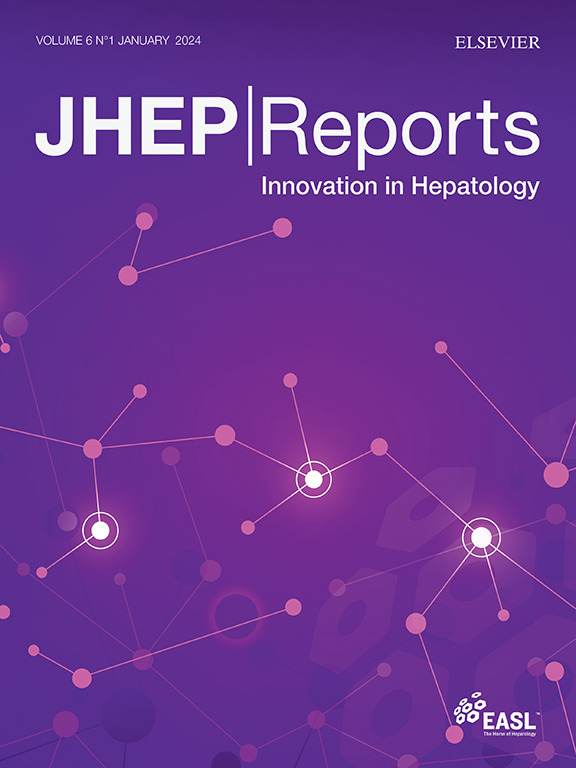Consistent improvements in liver histology across subgroups in a post hoc analysis of the SYNERGY-NASH trial with tirzepatide
IF 7.5
1区 医学
Q1 GASTROENTEROLOGY & HEPATOLOGY
引用次数: 0
Abstract
Background & Aims
In the SYNERGY-NASH trial for metabolic dysfunction-associated steatohepatitis (MASH) with stage 2 or 3 fibrosis, tirzepatide, an agonist of the glucose-dependent insulinotropic polypeptide and glucagon-like peptide-1 receptors, effectively resolved MASH without worsening fibrosis in up to 73% of patients. We explored the extent of histological improvements across clinically relevant subgroups in this trial.
Methods
Participants (n = 190) were randomly assigned 1:1:1:1 to receive once-weekly subcutaneous tirzepatide (5, 10, or 15 mg) or placebo for 52 weeks. We analyzed 155 participants who completed the study on treatment with evaluable end-of-treatment biopsies. Post hoc subgroups (n = 34) were defined by demographics, histology, serum, and imaging biomarkers using the median of baseline values for continuous variables. Risk differences (RDs) vs. placebo (95% CI) were calculated using a logistic regression model.
Results
Compared with placebo, tirzepatide was consistently associated with improved MASH resolution without worsening fibrosis across subgroups defined by sex, age, ethnicity, BMI, type 2 diabetes status, histological disease activity, fibrosis stage, serum aminotransferases, serum biomarkers of fibrosis and MASH, and imaging assessments of liver fat, fibroinflammation, and stiffness. For tirzepatide 5, 10 and 15 mg, RDs were statistically significant (p <0.05) for 74%, 97%, and 100% of the subgroups, respectively. While most RDs for fibrosis improvement without worsening of MASH favored tirzepatide, statistical significance was not reached in 59–79% of subgroups due to limited sample sizes. Significant fibrosis improvement (p <0.05) was observed with tirzepatide 5 and 15 mg among participants with stage 3 fibrosis.
Conclusion
These post hoc analyses suggest that tirzepatide was consistently associated with improved MASH resolution without worsening of fibrosis across subgroups defined by demographics, histology, and biomarkers, compared with placebo.
Impact and implications
In participants with metabolic dysfunction-associated steatohepatitis (MASH), tirzepatide demonstrated superiority to placebo for resolution of MASH without worsening of fibrosis, but the extent of MASH resolution across clinically relevant subgroups was not reported. In these post hoc analyses, we show that tirzepatide was consistently associated with improved MASH resolution without worsening of fibrosis across subgroups defined by demographics, histology, serum biomarkers, and imaging tests. These data support further investigation of tirzepatide in larger studies of participants with MASH including representation from diverse populations.

在替西肽的协同- nash试验的事后分析中,各亚组肝脏组织学的持续改善
背景,在针对伴有2期或3期纤维化的代谢功能障碍相关脂肪性肝炎(MASH)的SYNERGY-NASH试验中,替西肽(一种葡萄糖依赖性胰岛素性多肽和胰高血糖素样肽-1受体的激动剂)在高达73%的患者中有效地解决了MASH,而不会恶化纤维化。在本试验中,我们探讨了临床相关亚组的组织学改善程度。方法190例受试者按1:1:1:1随机分组,接受每周一次的替西帕肽(5、10或15 mg)皮下治疗或安慰剂治疗,疗程52周。我们分析了155名通过可评估的治疗结束活检完成治疗研究的参与者。事后亚组(n = 34)由人口统计学、组织学、血清和成像生物标志物定义,使用连续变量基线值的中位数。使用逻辑回归模型计算风险差异(RDs)与安慰剂(95% CI)。结果:与安慰剂相比,替西帕肽在性别、年龄、种族、BMI、2型糖尿病状态、组织学疾病活度、纤维化分期、血清转氨酶、纤维化和MASH的血清生物标志物、肝脂肪、纤维炎症和僵硬的影像学评估等亚组中始终与改善MASH分辨率相关,而不恶化纤维化。替西肽5、10和15 mg组的RDs分别为74%、97%和100%,差异均有统计学意义(p <0.05)。虽然大多数改善纤维化而不恶化MASH的rd倾向于替西帕肽,但由于样本量有限,59-79%的亚组未达到统计学意义。在3期纤维化患者中,替西帕肽5和15mg可显著改善纤维化(p <0.05)。这些事后分析表明,与安慰剂相比,替西帕肽在人口统计学、组织学和生物标志物定义的亚组中始终与改善MASH分辨率相关,而不会导致纤维化恶化。影响和意义在代谢功能障碍相关脂肪性肝炎(MASH)患者中,替西帕肽在缓解MASH而不恶化纤维化方面优于安慰剂,但在临床相关亚组中,MASH的缓解程度尚未报道。在这些事后分析中,我们发现替西肽在人口统计学、组织学、血清生物标志物和影像学检查定义的亚组中始终与改善的MASH分辨率相关,而不会恶化纤维化。这些数据支持在更大规模的研究中对替西帕肽进行进一步的研究,这些研究包括来自不同人群的代表。
本文章由计算机程序翻译,如有差异,请以英文原文为准。
求助全文
约1分钟内获得全文
求助全文
来源期刊

JHEP Reports
GASTROENTEROLOGY & HEPATOLOGY-
CiteScore
12.40
自引率
2.40%
发文量
161
审稿时长
36 days
期刊介绍:
JHEP Reports is an open access journal that is affiliated with the European Association for the Study of the Liver (EASL). It serves as a companion journal to the highly respected Journal of Hepatology.
The primary objective of JHEP Reports is to publish original papers and reviews that contribute to the advancement of knowledge in the field of liver diseases. The journal covers a wide range of topics, including basic, translational, and clinical research. It also focuses on global issues in hepatology, with particular emphasis on areas such as clinical trials, novel diagnostics, precision medicine and therapeutics, cancer research, cellular and molecular studies, artificial intelligence, microbiome research, epidemiology, and cutting-edge technologies.
In summary, JHEP Reports is dedicated to promoting scientific discoveries and innovations in liver diseases through the publication of high-quality research papers and reviews covering various aspects of hepatology.
 求助内容:
求助内容: 应助结果提醒方式:
应助结果提醒方式:


